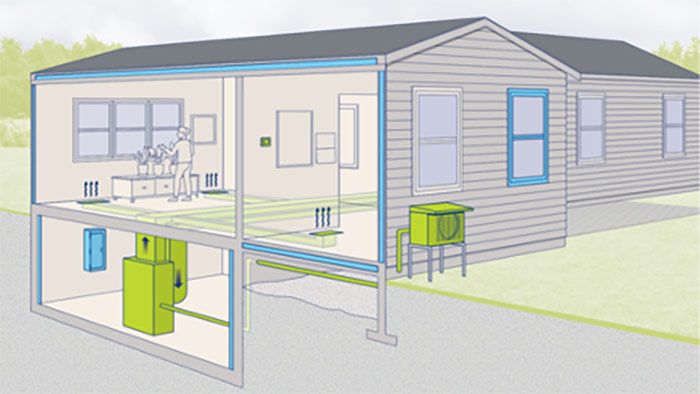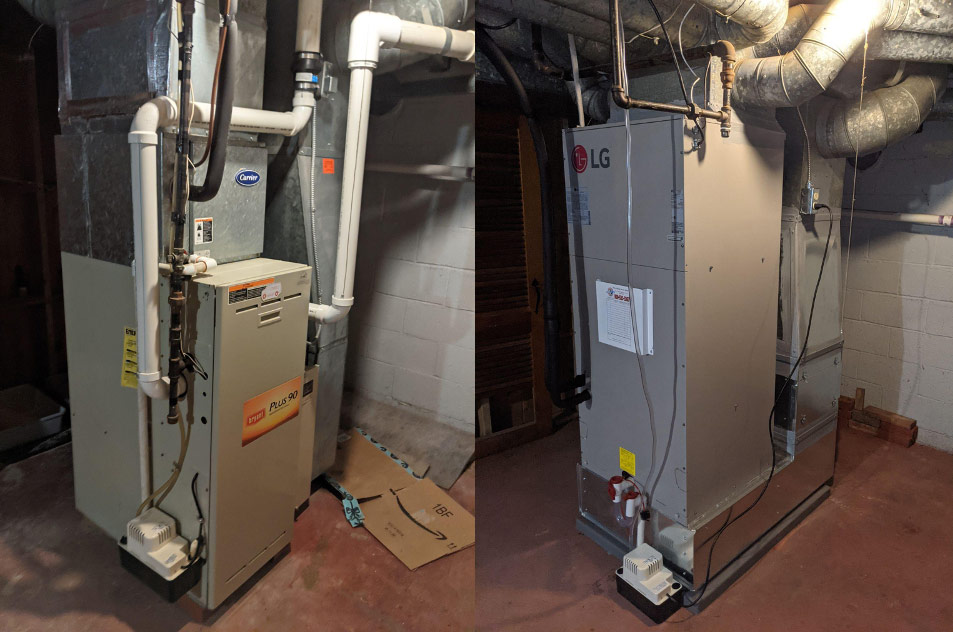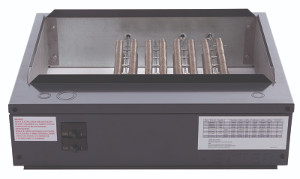Planning a Furnace-to-Ducted Heat Pump Retrofit
Understand the advantages of using an air handler when replacing a gas furnace with heat-pump technology.

By Jon Harrod
Installation of cold-climate heat pump HVAC systems is increasing rapidly as states pursue decarbonization goals and homeowners recognize the environmental, health, and economic benefits of moving away from fossil fuels. Cold-climate heat pumps offer a huge degree of design flexibility; options for indoor units include high- and low-wall-mounted ductless heads, ceiling cassettes, and low-profile “compact-ducted” units. One design, in particular, has tremendous potential to scale: It is what many manufacturers refer to as the “multi-position air handler” or “vertical air handler.” These units (referred to as air handlers for the rest of this article) have a form factor—or hardware design—similar to a conventional natural gas or propane furnace. They can be installed in upflow, downflow, and horizontal configurations.
According to EIA data from 2015, about 53.8 million housing units in the U.S. have forced-air systems burning natural gas, propane, or fuel oil as their primary heating source. This represents about 79% of the housing units that use fossil fuel and about 46% of all housing units. Converting these furnaces to heat-pump air handlers presents a viable path to electrifying a large segment of our housing stock.

Advantages of air handlers over ductless minisplits
For homes with existing ductwork, air handlers are often the best choice. Compared to a strategy of putting ductless heads in multiple rooms, air handlers offer several advantages, including:
The ability to deliver heated and cooled air to every room. With ductless systems, it is usually cost-prohibitive to install a head in every room in the house. It is also a poor design strategy since even the smallest ductless heads can be oversized for small rooms. A typical ductless design leaves some rooms without their own source of heated and cooled air. This approach can work well—or at least well enough—in newer buildings with open floor plans, good airtightness, and modern insulation levels. In older buildings, this approach can lead to comfort complaints.
Reduced visual impact. An air handler can be located out-of-sight in a basement, utility room, or attic, eliminating the need for visually intrusive heads in the living space and reducing the number of line sets and line set covers on the exterior of the house.
High indoor air quality. Unlike ductless heads, which only offer bare-minimum filtration, air handlers can incorporate MERV-13 filters capable of removing fine particles. Air handlers can also be integrated with central ventilation systems (including heat- and energy-recovery ventilators), whole-house dehumidifiers, and ventilating dehumidifiers, which provide both fresh air and moisture removal. An air handler can distribute this fresh, filtered, dehumidified air around the home while also mixing the air to dilute locally high concentrations of contaminants such as carbon dioxide.
Familiar user interface and better temperature control. Switching from a fossil-fuel furnace or boiler with wall-mounted thermostats to ductless heat pumps with handheld remote controllers can involve a significant adjustment for occupants. One of the biggest issues is that the target temperature set using the remote can differ by several degrees from the actual air temperature experienced by the occupant. This discrepancy is due mainly to the fact that most ductless units measure temperature with sensors on the heads themselves. Air handlers sample temperature using wall-mounted controllers that resemble conventional thermostats. This approach yields a much better match between the target temperature shown on the controller and the air temperature in the room.
Centralized condensate removal. In cooling mode, heat pumps remove moisture from the air. This liquid, or condensate, needs to be piped away, either to the outdoors or to a drain. Most ductless heads are installed to allow condensate to drain by gravity. If the drain is improperly pitched or clogged, the condensate in the drain pan can overflow, causing damage to walls, floors, and furniture in the finished space. Although pan overflow switches are available for ductless units, they are rarely installed. Small condensate pumps made specifically for ductless heads are available for applications in which gravity drainage is impossible. Unfortunately, many customers find these pumps too noisy for quiet spaces like bedrooms.
Air handlers can be put in utility rooms where condensate overflow is less likely to cause costly damage. In these locations, pump noise is also much less of an issue. Air handlers are also designed to incorporate secondary drains (which provide a backup in case the primary drain becomes blocked) and overflow switches (which stop system operation in the event of a drain failure).
Simplified maintenance. Heat pumps require annual maintenance of the indoor and outdoor units. A cleaning solution is used to rinse dirt and debris from the indoor coil and drain pan. For ductless units, the surrounding wall and floor must be protected with a plastic bib or sheeting; furniture and wall hangings may also need to be moved. For a system with multiple heads, the maintenance process is costly and time-consuming. Compared to a multi-head ductless system, maintenance on an air handler can be quicker and less intrusive.
Integrated auxiliary/backup heat. In a heat-pump system, auxiliary or “aux” heat is a secondary heat source that kicks in when the heat pump is unable to meet demand. This may occur in very cold weather when the output of the heat-pump system is unable to keep up with the heat loss of the house. Aux heat may also be used to recover quickly from a deep temperature setback and to provide uninterrupted heating while the heat pump goes through its defrost cycle.
More about backup heat
Because cold-climate heat pumps can maintain their output to temperatures well below 0°F, it’s possible to design systems that don’t require aux heat. But a heat pump that’s designed to cover the full heat load on the very coldest days may be significantly oversized for more typical conditions. Thoughtfully incorporating aux heat into a heat-pump design can allow the use of a smaller heat pump that will be a better overall match.
Emergency heat is utilized if the heat pump stops working. Powered emergency heat—for example, electric baseboard—can take over if the heat pump suffers a failure of its compressor or circuit board. But, unless the house has backup power, this emergency heat will not work during a power outage. Wood stoves and vented gas/propane heaters without blowers can serve as emergency heat in the event of an extended power outage. (As Allison Bailes and others have noted, good insulation and airtightness can also provide resilience during grid failures).
Although aux and emergency heat play different roles, they are usually provided by the same equipment. For ductless systems, this is often some form of electric resistance heaters in the living space—baseboard, wall heaters, or radiant mats. These resistance heaters—operating on 120V or 240V AC power—are typically controlled by their own line-voltage thermostats separate from the ductless controls. A common strategy is to set these resistance heaters to turn on if room temperature drops several degrees below the ductless setpoint. This approach can work but is subject to human error: If an occupant turns up their baseboard thermostat for temporary comfort heating and forgets to turn it back down, the heat from the inefficient baseboard may prevent the operation of the much more efficient heat pump.
Air handlers are designed to incorporate electric resistance elements (“heat strips”) for aux and emergency heat. In some, such as the LG LVN series, the heat strips are installed in the air-handler cabinet itself. In others, such as the Mitsubishi SVZ series, the heat strips are installed in a separate cabinet downstream of the air handler. Controls allow for seamless integration of aux and emergency heat. For customers desiring maximum comfort, the aux heat can be set to come on during the defrost cycle, masking the temporary interruption of heat from the compressor. For those seeking maximum efficiency, the heat strips can be “locked out” so that aux heat will not operate unless the outdoor temperature falls below a predetermined setpoint. Some controllers also allow the system to switch automatically to emergency heat in the event of a failure of the outdoor unit.

Although it’s tempting to think of furnace-to-heat pump air handler retrofits as simple “box swaps,” there are several places along the way where things can go wrong, leading to callbacks, poor comfort, and excessive energy use. I’ve been involved in dozens of these retrofits, including my own home, and have experienced the learning curve firsthand. In upcoming articles, I’ll talk about the information I gather when planning a heat-pump retrofit, then dig into equipment selection, layout, installation, and commissioning, which are all critical to getting a good result.
The full article series
Planning a Furnace-to-Ducted Heat-Pump Retrofit, Part 1: Needs Assessment
Planning a Furnace-to-Ducted Heat-Pump Retrofit, Part 2: Data Collection
Planning a Furnace-to-Ducted Heat-Pump Retrofit, Part 3: Sizing Calculations
Planning a Furnace-to-Ducted Heat-Pump Retrofit, Part 4: Zoning and Equipment Selection
Planning a Furnace-to-Ducted Heat-Pump Retrofit, Part 5: Installation
Planning a Furnace-to-Ducted Heat-Pump Retrofit, Part 6: Commissioning and Customer Education
_________________________________________________________________________
Previously published on GreenBuildingAdvisor.com. Jon Harrod is founder of Snug Planet, a contracting company in Ithaca, N.Y. Check out this episode of the Buildings + Beyond podcast to hear Jon talk about “The Role of Heat Pumps in Low- and Moderate-Income Homes.”






View Comments
A high efficiency gas furnace as emergency heat allows a modestly-sized generator to provide coverage in power outage situations, as the heat pumps and baseboard heaters have a much higher demand.